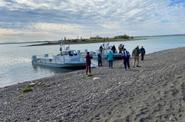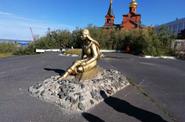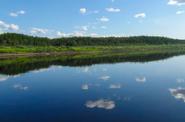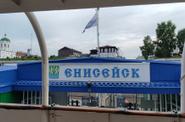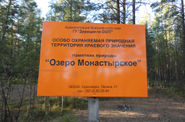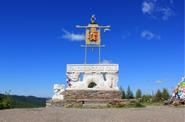The city of Norilsk
It got its name from the name of the area where it is located: the Norilsk River (Norilka) flows near the city (the basin of the Pyasina River), the city itself is located near the Norilsk Mountains. Travelers Khariton Laptev, A.F. Middendorf, F.B. Schmidt mention the Norilsk River and the Norilsk Mountains in their reports.
There are many versions of the origin of the name of the Norilka River. According to one version, the name of the river came from the word "norilo" – a long thin pole that stretched the bowstring of the shutter nets under the ice from hole to hole, according to another – the name of the river and, accordingly, the city comes from the Evenk word "narus" or Yukaghir "nyoril", which means "swamps".
Putoransky State Nature Reserve (1,887,251 ha, established in 1988)
It has been declared a World Heritage Site. It is located on the border of the Taimyr and Evenki Autonomous Districts of the Krasnoyarsk Territory. The reserve occupies the central – the most elevated – part of the vast and almost untouched by civilization Putorana plateau. The peripheral, lower areas of this plateau, adjacent to the reserve from the west, north and east, have the status of its buffer zone; this "semicircle" is recognized at the same time as the buffer zone of the World Heritage Site.
Putorana Plateau
This is a unique natural complex in terms of picturesqueness, with the highest concentration of waterfalls and mountain lakes, even by world standards, including extremely exotic – narrow, long and deep "fjord lakes", as well as a whole complex of high flat-topped massifs separated by deep and wide stepped canyons.
Lama Lake
Northern Switzerland, Taimyr Baikal, polar Ritsa. This is perhaps the most beautiful and famous lake of Taimyr. Even his name is similar to the rest of the northern hydronyms. The lake is located in a deep mountain depression. Its basin is of tectonic origin. According to scientists, the lake is about 100 million years old. The name of the lake comes from the Tungusic-Manchurian word "laamu" – sea, ocean; Evenk "lamu" - sea, big water. By the way, the same name – Lama – Evenks, who lived much further south, called Baikal.
The city of Dudinka
The coldest (rarely, but sometimes up to -57 ° Celsius) and the northernmost (69°21's) city on the planet. It is located on the right bank of the river. The Yenisei River at the confluence with the Dudinka River, named after the first Russian artisan Dudin, who settled here in the first half of the XVII century, just above the mouth of the river. And the city got its name from the name of the Dudinka river.
According to another version, the name of the city came from the Russian transcription of the Evenk words "dugin" (channel, island between channels, mouth of the channel) and "dugu" (cape of the river). The accusative case of the word "dugin" sounds like "duginma". And finally, according to the third version, from the Russian transcription of the word Encev–somatov (in the XVI - XVII centuries they roamed in the area of modern Dudinka and adjacent areas along the right and left banks of the Yenisei) "kaduta" ("purple place") – that's what they called the place on the high right bank of the Yenisei, where Dudinka now stands.
Igarka City
It is located on the shore of the Igara Bayou of the Yenisei, 1,330 km north of Krasnoyarsk in a straight line (the distance along the Yenisei is about 1,800 km). It is located beyond the Arctic circle, in the permafrost zone. The city was named after the channel on which it was located, and that, in turn, after the local fisherman Egor Shiryaev, whose name the locals turned from "Egorka" into "Igarka". Now it is a port accessible to ships from the Yenisei Bay.
The village of Turukhansk
It is located at the confluence of the Lower Tunguska with the Yenisei, 1,474 km north of Krasnoyarsk. The population is 4.8 thousand inhabitants. Founded in 1607 as a winter quarters, since 1619 it has been inhabited by settlers of the burnt-out city of Mangazeya.
The former Turukhansk became the settlement of Staroturukhansk, and the modern settlement with the name Turukhansk (the administrative center of the district) was previously named Novoturukhansk. In the 19th and 20th centuries, it was a place of exile (including I. V. Stalin in 1914-1916).
The attraction of the village is the Trinity Church (late 18th – early 19th century). In Turukhansk there is a fish factory, an oil and gas exploration expedition, a river port, an airport, a museum of revolutionaries Y.M. Sverdlov and S.S. Spandaryan.
The Lower Tunguska River
In the 17th century, Russian explorers named the river Nizhnyaya Tunguska. Tunguska – because Tunguska (modern Evenki) lived on its shores, and the definition of Nizhnyaya distinguished it from the other two Tunguska.
The Podkamennaya Tunguska River.
This is a rapid river, characterized by a kind of wild beauty. Its length is 1865 km. It is named Podkamennaya because it makes its way to the Yenisei through many hundreds of kilometers through stone cliffs. After 40 km, the Osinovsky threshold begins – the legendary narrow canyon, which is overcome with great difficulty. The passage through the threshold is narrow (700 m) and winding. Two steamers cannot separate, and the traffic here is one-way.
Village Vorogovo
It was founded more than 350 years ago during the development of Siberia in the 17th century by Cossacks. The population is represented by different nationalities: Russians, Germans, Ukrainians, Belarusians, Keto. Now it has about 2,000 thousand people, local residents organize markets with a wide variety of goods and souvenirs of local craftsmen at the pier by the arrival of the ship.
Village Yartsevo
It is located in the middle reaches of the Yenisei River between two large left tributaries – the Kas and Sym rivers. A local market is also organized here for the arrival of the ship.
The city of Yeniseisk
It is located on the Yenisei plain, on the left bank of the Yenisei, below the confluence of the Angara River, 330 km north of Krasnoyarsk. The city of Yeniseisk is called an "open-air museum", the urban development includes 94 architectural monuments.
The complex of the Transfiguration Monastery and four churches are unique examples of Siberian Baroque, built in the middle and second half of the XVIII century. They are close to the Russian temples of the previous century in terms of planning and spatial structure and picturesque decor.
The stone civil buildings of Yeniseisk are mainly two–storey houses along the main street, on the embankment and central squares.
Strelka is the place where the Angara flows into the Yenisei
There are many beautiful legends about the beautiful Angara, the only daughter of the old man of Lake Baikal, and the mighty handsome Yenisei. Baikal was against their wedding, following his fleeing daughter, he abandoned the palace, which was supposed to be her wedding gift. The palace fell apart into many fragments, they became the Strelkov threshold, and the largest stone is the Guard Island. Nothing could stop the wayward daughter on the way to the Yenisei: neither the ferocious rapids, nor the scattering of stones, nor the cliffs that stood in the way of the fugitive.
Stolby Nature Reserve
The natural boundaries of the protected area are the right tributaries of the river. Yenisei: in the northeast is the Bazaiha River, in the south and southwest are the Mana and Bolshaya Sluznevka Rivers. From the northeast, the territory borders with the city of Krasnoyarsk.
The reserve was founded in 1925 on the initiative of the residents of the city to preserve the natural complexes around the picturesque syenite remnants – "pillars". Currently, its area is 47,219 hectares.
The main attraction of the reserve are the rocks. The name "Pillars" is common to all rocks, although all rocks and even some stones have their own names. There are directly "Pillars" – rocks open to tourists, and "Wild pillars" – rocks located deep in the reserve, access to which is limited.
















